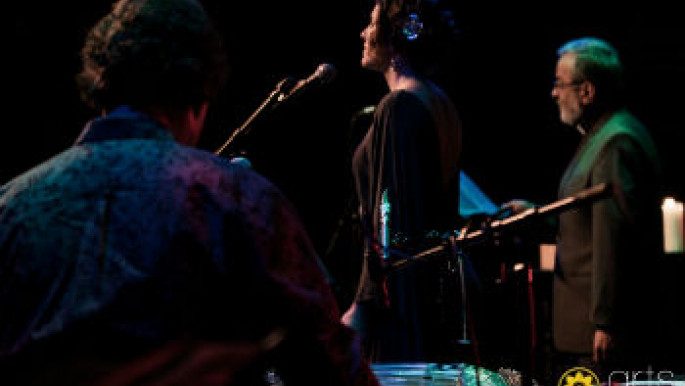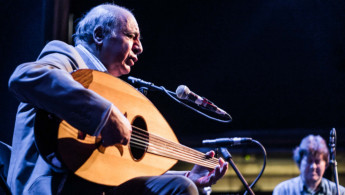Arab-Christian chants embody Middle East's shared cultural heritage
In the music of Arab Christians lies an indelible footprint of the past; a rich cultural capital accumulated through centuries of diverse civilisations and traditions in the Middle East.
From the Coptic monasteries of Egypt to the Maronite churches of Lebanon - with Greek Orthodox Palestinians nestled in-between in Christianity's birthplace -ancient chanting traditions reflect the diversity, and interconnectedness of Arab culture. Yet they are rarely heard outside of the region.
Usually reserved for intimate communal prayers or liturgical celebrations, their spiritual melodies reverberated across London in January, as Orthodox and Coptic communities celebrated Christmas, in a candle-lit event showcasing the songs of Aramaic and Byzantine chanting music.
Performed by Coptic Egyptian-German singer Merit Ariane Stephanos and Reverend Shafiq Abouzayd - the senior Melkite priest in Britain - along with Lebanese-born singer and oud player Najib Coutya, with Hala Arsalan, a Syrian-British soprano, such traditions embody the pluralism of Arab culture.
"Arab communities are really proud of their diverse heritage, whether Muslim or Christian. For the Arab community, it is really important to be represented in a multifaceted way,"Stephanos told The New Arab.
"These chants are really crucial because they are this bridge, a symbol, which shows that we are much more united than the world makes us out to be."
| Listen: Marie Keyrouz performs a traditional Maronite chant |
Trained in western classical music, Stephanos' interest in Arab-Christian chants developed after living in Bosnia for a year, where she became fascinated by the blend of traditions in local Sevdah, or "yearning", music.
Combining Turkish and local Bosnian folk rhythms, the music is centered on the maqam, a modal structure defining Arabic music which utilises quarter tones and relies on improvisation techniques.
After studying Arab-Christian chants in Lebanon, whose history has certain parallels with the civil war and political divisions which plagued Bosnia, Stephanos became fascinated by the historical thread, and dialogue, tying together the tapestry of musical traditions in the Middle East.
"The chants have an almost healing, spiritual power, they capture a yearning. It has ancient roots but is still a living tradition,"she says.
 |
|
| Merit Ariane Stephanos performs Aramaic and Byzantine chants at Rich Mix in London [ArtsCanteen] |
Arab-Christian chants can be divided into three main branches - Coptic, Byzantine (including both Greek Catholics and Greek Orthodox) and the Syriac-Aramaic church.
Even within these traditions, there is much variety.
Maronite chants in Lebanon have a distinct tonal melody, for example, likely due to the community's historic isolation in mountainous terrain, whereas Syriac chants have been influenced by the ornate musical traditions of the Byzantine Empire.
The shared geographical history of different communities in the Levant region has produced a symbiosis between musical traditions in prayer and worship, challenging the prevalent stereotype of the region as steeped in primordial sectarianism.
"Politicians try to divide and rule. They try and make you afraid of each other. This music is breaking the narrative that we are different,"Stephanos says.
Sharing the maqam system of melodies to recite the Quran, Arab Christian Orthodox chants are reminiscent in their tone and melodies to the Azaan, or call to prayer. Stephanos recounts waking up on Easter morning in Beirut to what she thought was the call of the muezzin, only to discover Greek Orthodox priests chanting from the rooftops in worship.
"It's all maqam," says Richard Dumbrill, a leading expert in the archaeomusicology of the Ancient Near and Middle East.
"The chanting of the Islamic call to prayer is sung in five different maqams, each day, at each prayer, and the music of Christianity, which is well-preserved in Lebanon, uses the maqam for different services.
"There is no difference between their music, the instruments are the same."
| Listen: An Orthodox priest recites a Byzantine chant, from a more ornate tradition |
Dumbrill says there is a link between all of the musical traditions of Christianity, Islam and Judaism in the Middle East - with the exception of Jewish Ashkenazi music, which formed in central and Eastern Europe.
Lived traditions, ancient roots
Despite being lived musical traditions, Arab-Christian chants have deep historical roots. Research shows that some chants date back to the pre-Christian Babylonian Empire, which originated around 1800 BC.
With the advent of Christianity in the region, newly created churches simply adopted local melodies, most likely based on the maqam structure, and applied relevant religious lyrics used throughout the liturgical year.
"It's a tradition which is at least 4,000 years old. We can even trace it back to ancient Babylonian texts and music, in which we find the sources for maqam music," Dumbrill says.
| Listen: This Aramaic chant is an example of the rich musical tradition of the Syriac church |
In the south-eastern Turkish city of Mardin, near the Syrian border, Syriac priests were found to be chanting in a form of Aramaic that is near-identical linguistically to that spoken during the time of Jesus.
Indeed, a similar musical structure based on the maqam was used in European music, which was heavily influenced by the church, for several hundred years. After the separation of the western and Eastern Churches in the 6th century, the intonation of musical scales was changed to gradually eliminate any eastern influence and remain diatonic, Dumbrill says.
Partly in ode to this historical Babylonian legacy, one of Stephanos' performance groups is named Zanubia, a tribute to the queen who ruled over the ancient Syrian city of Palmyra, now a war-torn UNESCO heritage site, when Christianity first arrived in the city in the 3rd century.
Understanding this musical heritage helps disrupt the binary narrative of a Christian Europe and a Muslim Arab world.
| Video: Stephanos' group, Zanubia, performs Syriac and Byzantine chants |
Culture and music was once shared, with both regions much more culturally intertwined than contemporary political and epistemological discourse would reflect.
"Christian Europe wouldn't exist if it wasn't for the Middle East,"Stephanos says.
"These chants link the past and the present, they are a bridge between east and west. It's really important to get out there, so this narrative of us-and-them is not able to stand."
Ultimately, beyond its beauty and diversity, the music of Arab Christians embodies the critical notion that identities are always fluid.
At a time in the Middle East, and globally, when identity markers are being entrenched for political gain, the rich culture that diversity produces should be cherished, and gratefully embraced.
"Music doesn't solve anything, but it's a celebration, a memory, a symbol - it is art. Music is just a beautiful part of who people are. It is part of their fabric, part of their language, part of their traditions," Stephanos says.
"It shows you who they are."
Charlie Hoyle is a freelance journalist specialising in issues of Middle East culture and politics.
Follow him on Twitter: @CharlieCHoyle



